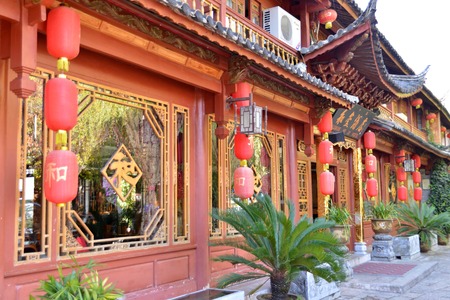Introduction to Feng Shui and Its Modern Relevance
Feng Shui, an ancient Chinese practice, is centred around the art of harmonising individuals with their surrounding environment by managing the flow of energy, or “qi.” One of its core principles is the way energy enters a home, particularly through the front door. In the context of the UK, where urban landscapes often feature busy roads and varied architectural styles, Feng Shui remains highly relevant. Many British homeowners are increasingly attentive to how their immediate surroundings—such as traffic flow and nearby streets—impact not only the aesthetic appeal but also the overall wellbeing experienced within their living spaces. By understanding how external factors like roads influence the movement of energy into a property, residents can make informed decisions that support both traditional wisdom and modern lifestyle needs. This ongoing integration of Feng Shui principles continues to shape UK home design, demonstrating a keen awareness of wellbeing beyond mere visual impression.
2. Understanding Roads in the British Urban Context
The impact of roads and traffic flow on front door Feng Shui is best understood by first examining the unique characteristics of British urban planning and residential arrangements. Unlike grid-like layouts found in some other countries, British towns and cities often feature a mix of winding streets, crescents, cul-de-sacs, and terraced housing. These elements shape how homes interact with nearby roads and influence daily life for residents.
Typical British Road Layouts
British roads are categorised into several types that directly affect residential environments:
| Road Type | Description | Common Impact on Housing |
|---|---|---|
| Main Road (A-road) | Major thoroughfares connecting different areas or cities; higher traffic volume | Noisier environment, greater air pollution, but easier access to amenities |
| Residential Street | Designed primarily for local access; lower speed limits and traffic volumes | Quieter surroundings, safer for families, stronger sense of community |
| Cul-de-sac/Close | Dead-end streets with minimal through-traffic; common in suburban developments | Very quiet, reduced risk from traffic, more privacy and security |
| Terrace Row Access | Narrow lanes or alleys serving rows of terraced houses, often with limited vehicle access | Pedestrian-friendly, less exposure to direct road energy, potentially cramped parking conditions |
Housing Arrangements and Proximity to Roads
In many UK cities, period terraces line up directly along the pavement with little or no front garden, while suburban semi-detached or detached homes typically feature driveways or small lawns separating the house from the street. The proximity of a home’s front door to the road thus varies significantly:
| Housing Type | Front Door Distance from Road | Potential Feng Shui Implications |
|---|---|---|
| Terraced House (Urban) | 1–2 metres; directly onto pavement or minor road | Greater exposure to fast-moving energy (“Sha Qi”), less buffer from external influences |
| Semi-Detached/Detached (Suburban) | 5–15 metres; set back with gardens or driveways | More gradual energy flow toward entrance, enhanced privacy and tranquillity |
| Cul-de-sac/Close Properties | Varies; often further from main traffic routes with communal green spaces | Smoother energy, lower noise levels, increased sense of safety for families and children |
The Interplay between Roads and Daily Life in the UK Setting
The layout of roads relative to front doors affects not only practical aspects such as access, noise levels, and safety but also the quality of environmental “Qi” reaching a property—an essential consideration in Feng Shui. In busy urban centres like London or Manchester, homes close to major roads experience more dynamic activity and potential disturbances. Conversely, in quieter villages or outer suburbs, the gentle curves of lanes and strategic setbacks foster calmer living environments. Thus, understanding these typical arrangements is vital for evaluating how UK-specific road features can influence front door Feng Shui outcomes.

3. The Flow of Qi: Roads, Traffic, and Energy Movement
In Feng Shui philosophy, the movement of qi—often translated as energy or life force—is significantly shaped by the physical environment surrounding a property. Roads and traffic patterns near the front door play a critical role in either enhancing or disrupting the harmonious flow of qi into a home. In the context of UK suburbs and towns, where terraced houses, cul-de-sacs, and winding streets are common, understanding these influences becomes particularly relevant.
Road Types and Their Influence
Different types of roads carry distinct energetic qualities. For instance, a busy high street directly facing a property may channel fast-moving, aggressive energy (known as sha qi) straight towards the front door. This is often considered unfavourable in traditional Feng Shui, as it can create a sense of restlessness or unease for occupants. Conversely, properties situated on quiet residential lanes or set back from main roads tend to receive gentler, more nourishing qi, fostering a calmer atmosphere within the home.
Direction and Approach
The direction from which a road approaches the front door is also significant. A T-junction—a common feature in many British neighbourhoods—where a road points directly at a property is traditionally seen as problematic. This configuration is believed to funnel excessive energy toward the house, potentially leading to instability or health concerns for its residents. By contrast, homes located on curved roads or crescent-shaped streets benefit from qi that meanders gently, supporting stability and well-being.
Traffic Flow Patterns
Beyond the physical layout of roads, the volume and speed of local traffic also impact energy movement. In UK towns with frequent rush-hour congestion or busy bus routes passing close by, the fluctuating intensity of traffic can disrupt the consistent flow of positive qi into the home. On the other hand, properties on one-way streets with moderate traffic are thought to experience more balanced energy due to less erratic movement outside their doors.
Understanding these nuances allows homeowners to make informed decisions about their property’s entrance orientation or apply remedial measures—such as planting hedges or using screens—to buffer against unwanted energetic influences while living harmoniously within uniquely British environments.
4. Front Door Placement and Local Road Patterns
In the context of the UK’s unique street layouts, the placement and orientation of a front door relative to nearby roads is a critical consideration in Feng Shui practice. The energy or “qi” that enters a home is thought to be heavily influenced by the movement and nature of traffic outside. Key road patterns found in British neighbourhoods—such as cul-de-sacs, busy main roads, and roundabouts—each present distinct challenges and opportunities for optimal Feng Shui outcomes.
Cul-de-Sacs
Properties situated on a cul-de-sac are common in suburban Britain. While cul-de-sacs tend to be quieter with less through-traffic, their circular layout can sometimes cause energy to stagnate or swirl unpredictably near the front door. This may result in either beneficial tranquility or, conversely, an absence of stimulating qi depending on the specific orientation of the entrance. Positioning the front door directly at the head of a cul-de-sac could amplify incoming energy but may also concentrate it too forcefully.
Busy Roads
Homes facing busy arterial roads or high streets experience a constant flow of fast-moving traffic, which is believed in Feng Shui to bring aggressive or “sha qi.” Such forceful energy can disrupt harmony within the home if the front door opens directly onto the road without adequate shielding. British homes often use hedges, walls, or even traditional porch structures as buffers, helping to soften harsh influences before they reach the threshold.
Roundabouts
Roundabouts are a distinctive feature of UK road design, especially in urban and suburban areas. Properties located near roundabouts may encounter rapidly circulating traffic flow that brings both dynamic energy and potential confusion. Depending on whether the front door faces towards or away from a roundabout’s entry points, the quality of qi entering the home can vary significantly.
Summary Table: Road Pattern Influence on Front Door Feng Shui
| Road Pattern | Typical Energy Effect | Feng Shui Considerations |
|---|---|---|
| Cul-de-Sac | Calm or stagnant; possible swirling qi | Avoid direct alignment at head; use landscaping for balance |
| Busy Road | Aggressive, fast-moving qi (“sha qi”) | Add barriers (hedges/walls); avoid direct exposure where possible |
| Roundabout | Dynamic but potentially chaotic qi | Orient door thoughtfully; buffer with plants or architectural features |
Local Context Matters
The interplay between traditional Feng Shui principles and British road layouts means that homeowners should assess not just the direction their front door faces, but also its relationship to surrounding traffic flows and street configurations. Thoughtful placement and appropriate buffering strategies can help harness positive energies while mitigating adverse effects from local road patterns.
5. Practical Implications for Homeowners
When considering the impact of nearby roads and traffic flow on your front door’s feng shui, it is essential for UK homeowners to adopt practical strategies tailored to local conditions. The first step is to conduct an honest assessment of how your home interacts with the street: is your front door facing a busy main road, a quiet cul-de-sac, or perhaps at the end of a T-junction? Each scenario presents unique challenges and opportunities in the context of energy flow.
Mitigating Negative Influences from Roads
If your property faces a direct road or is situated where traffic funnels towards your entrance, it may invite excessive yang energy, which can be disruptive. To counteract this, consider physical barriers such as hedges, fences, or even strategic planting. In many British neighbourhoods, evergreen shrubs like boxwood or holly serve not only as traditional garden features but also act as natural shields against fast-moving energy from the street. A well-placed gate or low wall can further soften the approach and buffer your home from noise and pollution.
Enhancing Positive Energy Flow
For those living on quieter streets or curved roads, it’s possible to enhance beneficial chi by keeping pathways to the front door clear and inviting. Well-maintained footpaths, attractive lighting, and tidy front gardens contribute to a welcoming atmosphere. In line with British customs, maintaining flowerbeds or hanging baskets with seasonal blooms can uplift both curb appeal and energetic harmony.
Adapting Solutions to Local Context
Urban dwellers may face additional challenges such as limited space or high pedestrian traffic. In these cases, subtle adjustments like installing wind chimes by the doorway or using specific colours for doors (such as classic British hues like navy blue or forest green) can be effective. For properties near roundabouts or busy intersections, reinforcing boundaries with brickwork—an enduring feature in UK architecture—not only adds character but strengthens protective energy around the home.
Ultimately, successful application of feng shui principles relies on thoughtful adaptation rather than rigid rules. By blending traditional wisdom with practical measures suited to the British environment, homeowners can create entrances that not only respect local culture but also nurture positive energy despite surrounding roadways.
6. Contemporary Perspectives and Cultural Adaptation
In the context of modern British life, the application of Feng Shui—especially regarding the influence of nearby roads and traffic flow on front door energy—requires a degree of reinterpretation. Many UK homeowners, while appreciating the essence of Feng Shui, often adapt its principles to fit both practical concerns and the unique characteristics of local architecture. For example, rather than strictly following traditional Chinese directional rules, British residents may focus more on the feeling of welcome and security at their entrance, which is highly valued in British culture. They might select robust doors, install well-maintained paths, or use hedges and planters as subtle barriers to soften the direct force of oncoming traffic or busy streets.
Moreover, the prevalence of terraced housing, narrow lanes, and historic layouts in many British towns means that textbook Feng Shui solutions are not always feasible. As a result, there is a tendency to blend Feng Shui guidance with established local practices such as creating inviting thresholds or ensuring adequate lighting at entry points—both for aesthetics and safety. This pragmatic fusion allows homeowners to preserve the spirit of positive energy flow while acknowledging the realities of urban planning and property constraints.
Additionally, contemporary British interpretations may place greater emphasis on psychological comfort rather than strict metaphysical beliefs. For instance, some homeowners use Feng Shui-inspired strategies as part of broader efforts to create calm, orderly spaces that help buffer against external stressors like heavy traffic noise or visual clutter from busy roads. In this way, Feng Shui becomes a flexible tool—one that supports wellbeing within the framework of modern lifestyles and the distinct built environment found across the UK.


